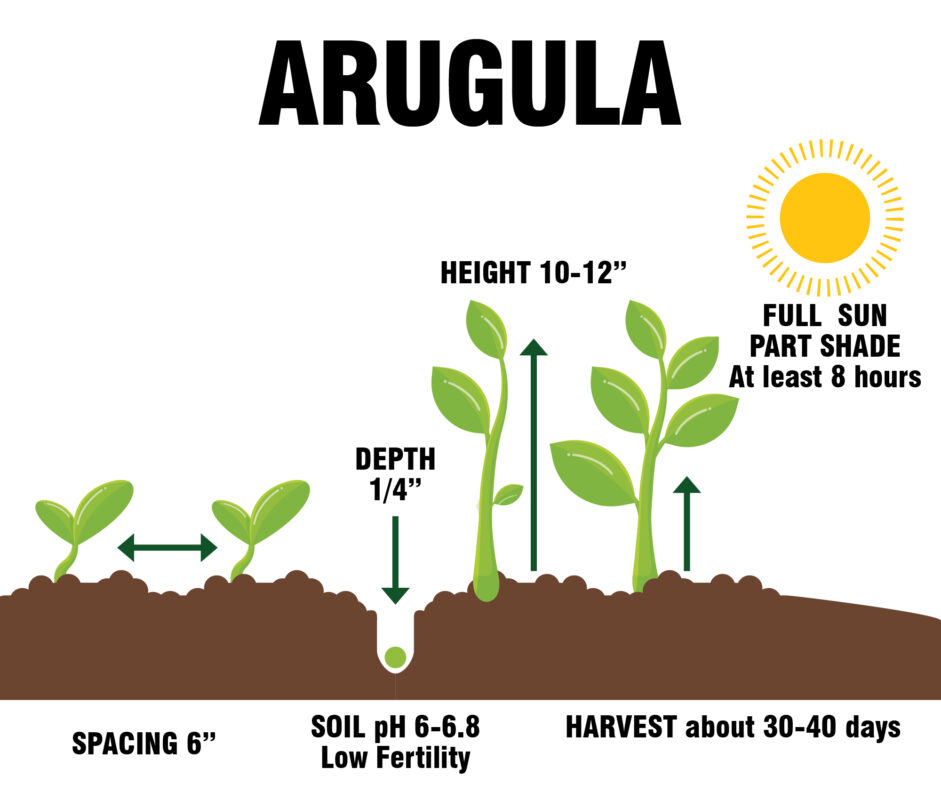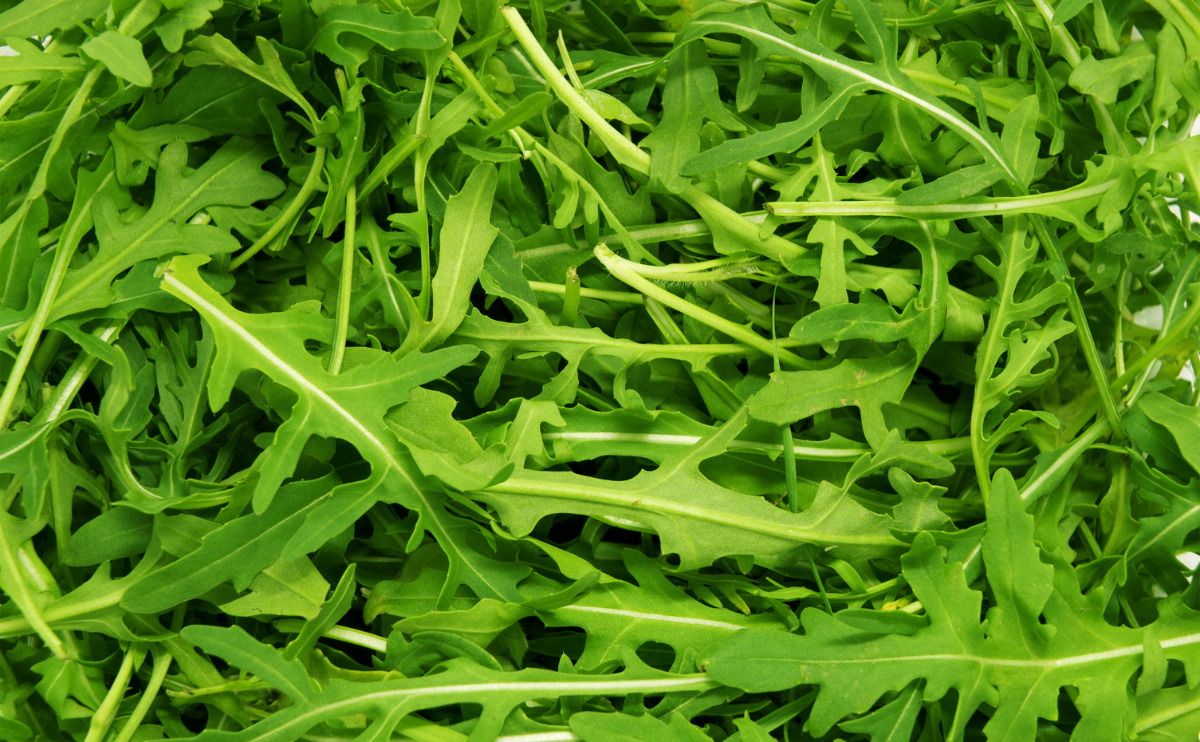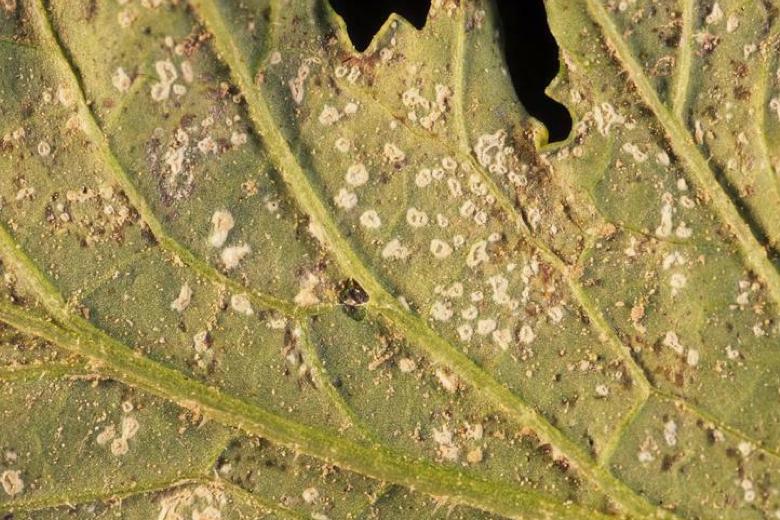Arugula (Eruca vesicaria) is a fast-growing annual leafy vegetable and a member of the mustard family that is grown as a flavorful salad green. It has a somewhat tart and peppery flavor. The leaves are deeply lobed and reach around 3 to 6 inches long. They grow in rosettes. As a cold-season vegetable, arugula can be planted in the early spring or late summer.

| Common Name | Arugula, rocket, garden rocket |
| Botanical Name | Eruca versicaria |
| Family | Brassicaceae |
| Plant Type | Annual, vegetable |
| Size | 2–3 ft. tall, 1–1.5 ft. wide |
| Sun Exposure | Full sun, part shade |
| Soil Type | Loamy, moist, well-drained |
| Soil pH | Acidic, neutral (6 to 7) |
| Bloom Time | Seasonal |
| Hardiness Zones | 2–11 (USDA) |
| Native Area | Mediterranean |

When to Plant?
This will be determined by your planting zone. There is a final frost date for each area. As a result, you can plan your gardening activities around this date. Check our Frost Dates Across North America: First & Last Frost Dates Chart. However, the date will not be the same for every plant.
How to Plant
Prefers rich humusy soil with pH of 6 to 6.8, but will tolerate a wide variety of conditions. Evenly moist soil will help slow bolting. Growth is low and compact until heat causes the plant to bolt. Forms a rosette of deeply lobed leaves. Plants become erect when heat induces bolting. Flowers are edible.
Plant ¼ inch deep and 1 inch apart in rows, or broadcast alone or mixed with other greens. Gradually thin to 6-inch spacings using thinnings for salads.
Make new plantings every 2 to 3 weeks for a continuous supply until about a month before your average first frost date.

Slow bolting by reducing heat and moisture stress. Provide some shade for warm-season plantings. Fast-growing plants are good for intercropping and relay cropping. Often self-seeds. Is self-sterile and requires insects for pollination. Will not cross with other members of the mustard family.
Your arugula will send up little white flowers with dark veins. Then little seed pods will form along the stem. These can be eaten fresh but beware, they are very spicy – they have a strong radish flavor. Next, the whole plant will start to turn brown. Cut off water at this point and let nature take its course. You may need to support the stems as they dry to keep them from falling over.
How to Cultivate
Soil – It prefers moist, well-drained soil
Sun – Full sun to part shade
Spacing – 6″
Water – Moist to dry (it’s adaptable)
Let the soil dry out completely before watering.
Fertilizer – This plant has no special fertilizing needs
How to Harvest
Arugula is ready to harvest in 40 days. To harvest Arugula, pick off the outside tender leaves at the base of the plant. Leave the center growing point intact for future harvesting. Discard larger leaves as they tend to get tough and very bitter tasting. Leaves can also taste bitter in warmer weather. Eat fresh or cooked like spinach.
Hydroponics
Germination: To start the germination process, soak arugula seeds in water for 24 hours before sowing them in your chosen hydroponic system.
pH range: The ideal pH range for arugula hydroponic growth is between 6.0 and 7.0. Monitor the pH levels regularly and adjust them accordingly using pH up or down solutions.
EC: The ideal electrical conductivity (EC) range for arugula hydroponics is between 1.0 and 1.8 mS/cm. Keep in mind that EC measures the level of nutrients in the solution, so you may need to adjust nutrient levels to maintain the appropriate EC range.
PPM: The ideal PPM (parts per million) range for arugula hydroponics is between 500 and 1000 ppm. Again, this range will depend on the specific nutrients you use, so monitor the PPM levels regularly and adjust as needed.
Humidity: Arugula prefers a relatively high humidity level, around 60-70%. Maintain proper humidity levels by using a humidifier or a humidity dome.
Light hours: Arugula requires at least 12-16 hours of light per day for proper growth. Use LED grow lights or natural sunlight to provide your plants with enough light.
Temperature air: Arugula plants grow best in temperatures between 60-68°F (15-20°C). Make sure to maintain a stable temperature range in your hydroponic system.
Temperature water: The ideal water temperature for arugula hydroponics is around 65-75°F (18-24°C). Too cold or too hot water can affect plant growth, so keep an eye on water temperature regularly.
That’s it! With the right conditions and attention, you should be able to successfully grow arugula hydroponically.



